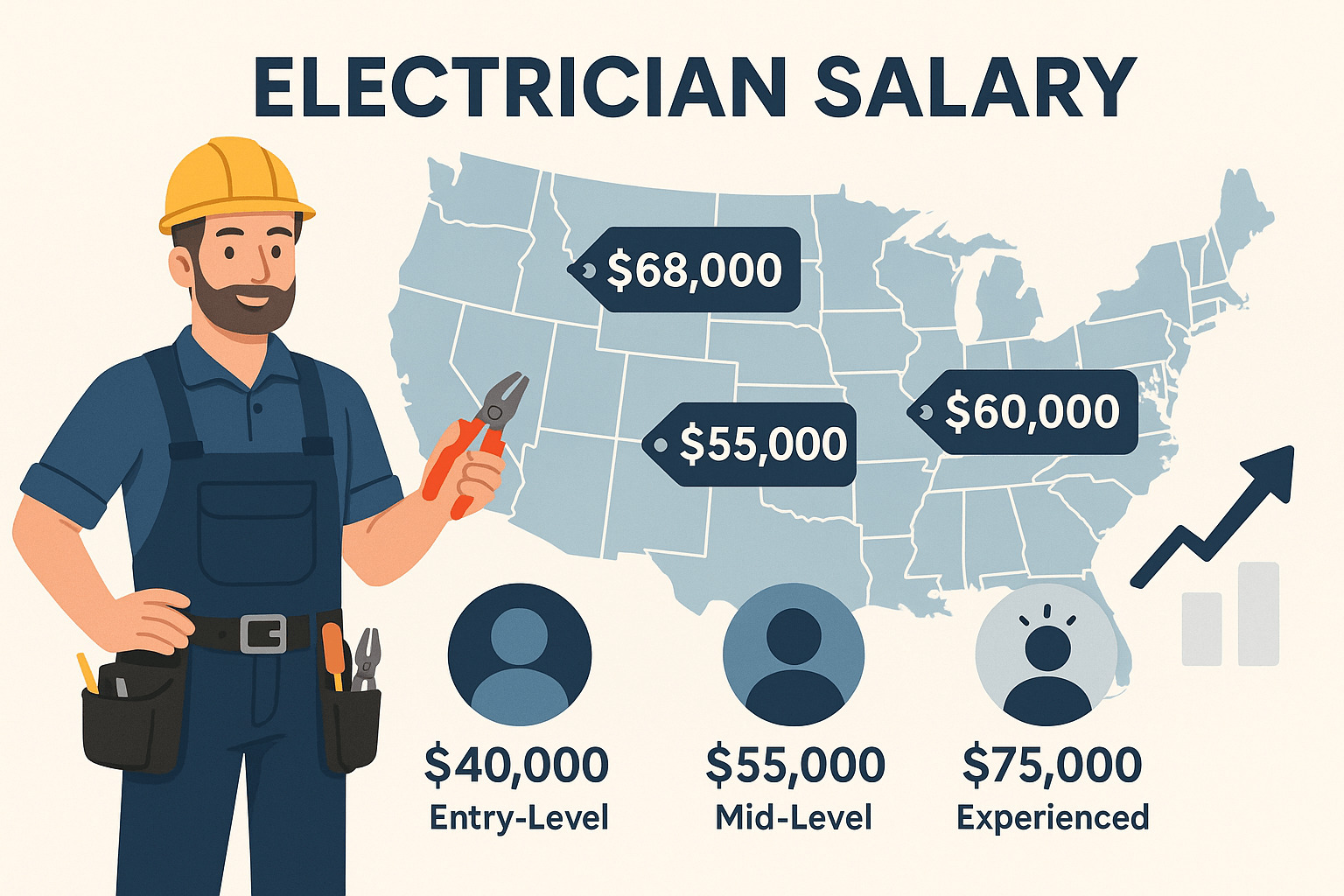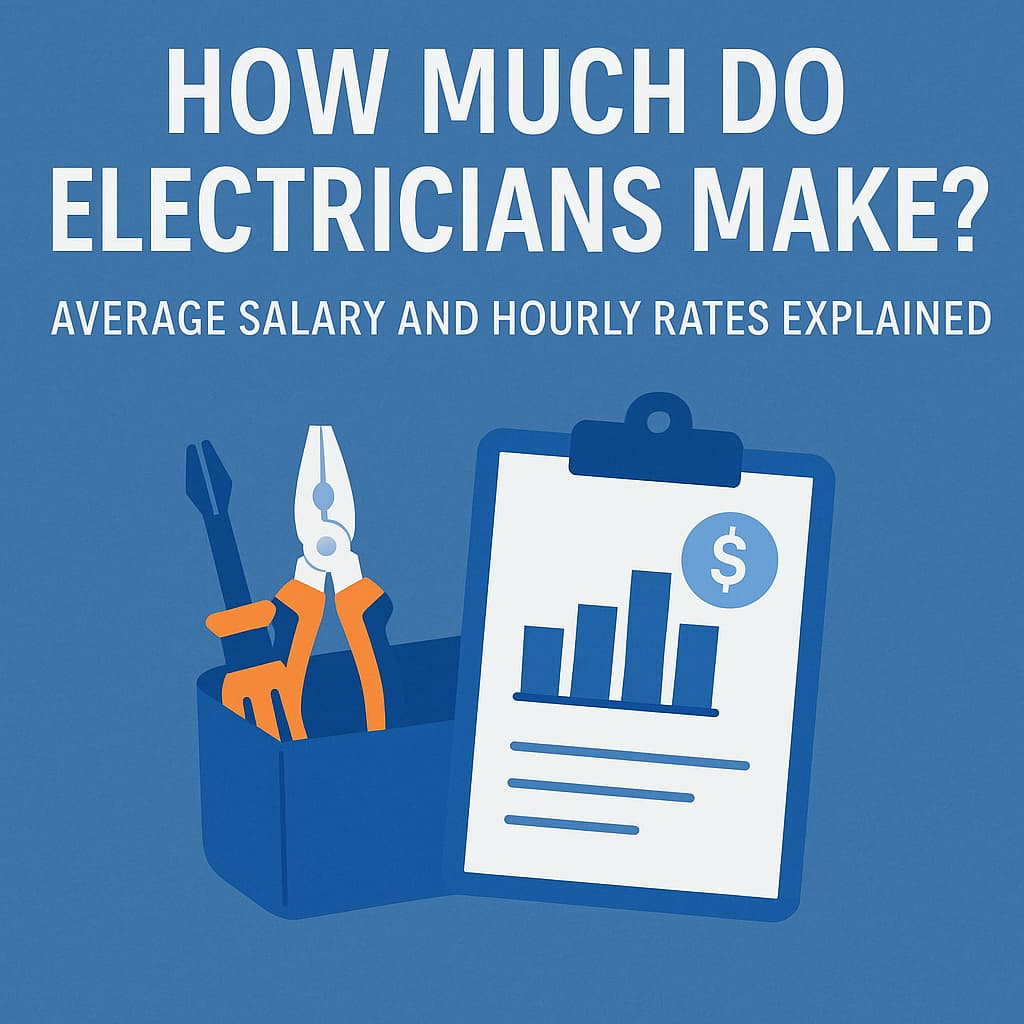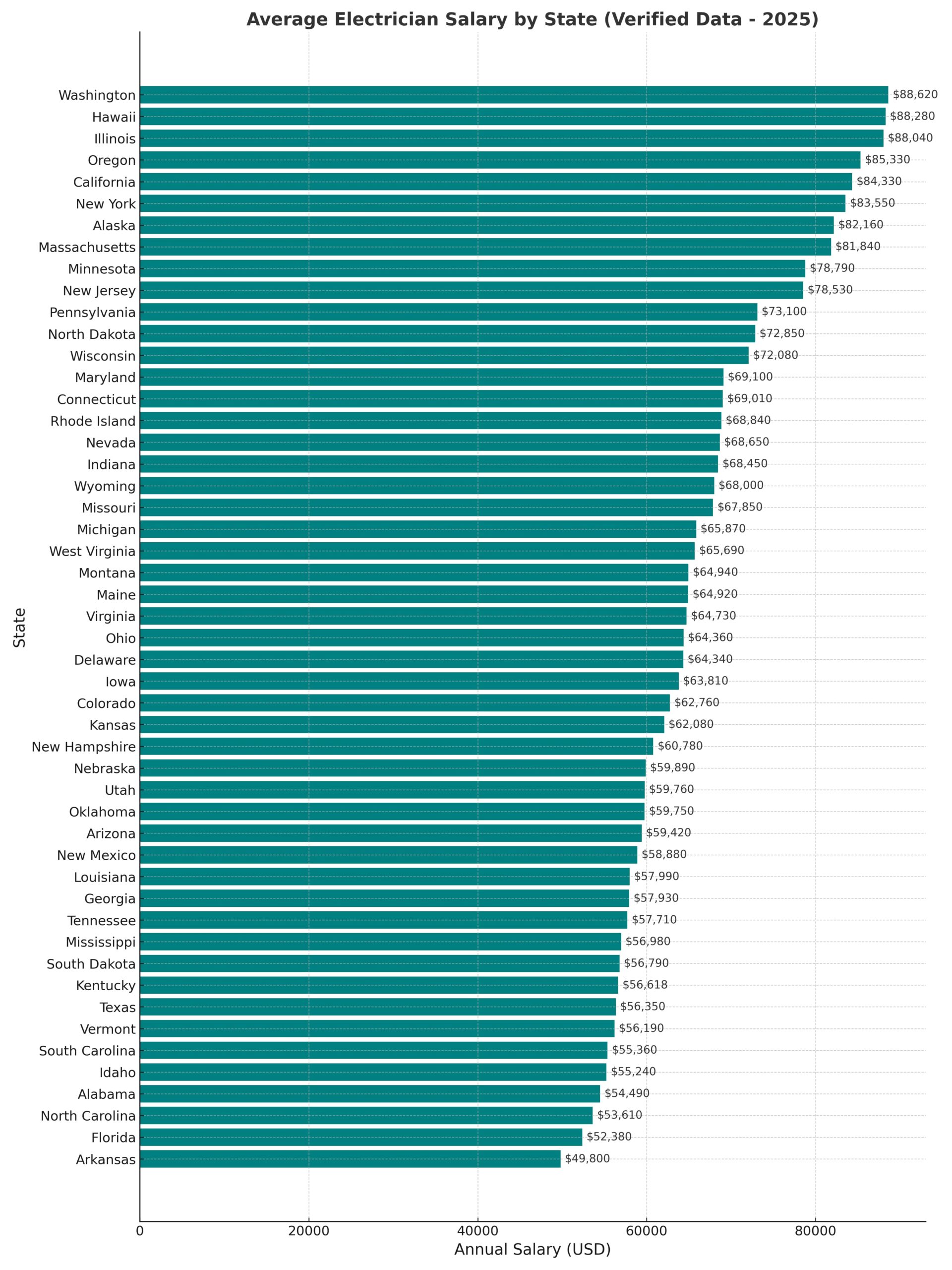
Average Salary, Hourly Rates & State Comparisons (2025)
Electricians are the backbone of the trade that keeps the United States running — powering homes, businesses, cities, and critical infrastructure. In this profession, the combination of technical skills, formal certification, and hands-on experience opens doors to steady income, competitive wages, and opportunities for advancement.
Whether you’re exploring job postings for apprenticeship roles or looking to expand your responsibility as a master electrician, this guide provides the most up-to-date information, salary estimates, and key factors that determine earnings across every category and location.

1. National Electrician Salary Overview
According to the U.S. Bureau of Labor Statistics, the median annual wage for electricians in May 2024 was about $62,350 — roughly $29.50/hour. However, electrician salaries can vary greatly depending on skills, certification, and where you work.
National Salary Estimates:
- Apprentice / Entry-Level: $40,000–$60,000/year
- Journeyman Electrician: $55,000–$75,000/year
- Experienced Journeyman: $70,000–$100,000+
- Master Electrician: $76,600 and above
Union electricians often see a 20% boost in compensation, plus additional benefits such as retirement plans, health coverage, and paid time off.
2. Salary by Experience Level
Electricians move through clear categories of experience, each with different responsibilities, wages, and expectations.
Chart: Average Salary by Experience Level (2025)

| Role | Annual Salary Range |
|---|---|
| Apprentice | $40,000 – $60,000 |
| Journeyman Electrician | $55,000 – $75,000 |
| Experienced Journeyman | $70,000 – $100,000+ |
| Senior / Master Electrician | $76,600+ |
Example: In San Francisco, an experienced journeyman might earn well above the national average due to high cost of living and strong demand for electrical services in the city.
3. State-by-State Salary Comparisons
Location plays a huge role in wage levels. States with high demand or a higher cost of living — such as California, Massachusetts, and Illinois — tend to offer higher pay, while states with fewer large urban areas may pay less but have lower expenses.
Chart: Average Electrician Salary by State (2025)

| State | Avg Annual Salary | State | Avg Annual Salary |
|---|---|---|---|
| Alabama | $54,490 | Montana | $64,940 |
| Alaska | $82,160 | Nebraska | $59,890 |
| Arizona | $59,420 | Nevada | $68,650 |
| Arkansas | $49,800 | New Hampshire | $60,780 |
| California | $84,330 | New Jersey | $78,530 |
| Colorado | $62,760 | New Mexico | $58,880 |
| Connecticut | $69,010 | New York | $83,550 |
| Delaware | $64,340 | North Carolina | $53,610 |
| Florida | $52,380 | North Dakota | $72,850 |
| Georgia | $57,930 | Ohio | $64,360 |
| Hawaii | $88,280 | Oklahoma | $59,750 |
| Idaho | $55,240 | Oregon | $85,330 |
| Illinois | $88,040 | Pennsylvania | $73,100 |
| Indiana | $68,450 | Rhode Island | $68,840 |
| Iowa | $63,810 | South Carolina | $55,360 |
| Kansas | $62,080 | South Dakota | $56,790 |
| Kentucky | $56,618 | Tennessee | $57,710 |
| Louisiana | $57,990 | Texas | $56,350 |
| Maine | $64,920 | Utah | $59,760 |
| Maryland | $69,100 | Vermont | $56,190 |
| Massachusetts | $81,840 | Virginia | $64,730 |
| Michigan | $65,870 | Washington | $88,620 |
| Minnesota | $78,790 | West Virginia | $65,690 |
| Mississippi | $56,980 | Wisconsin | $72,080 |
| Missouri | $67,850 | Wyoming | $68,000 |
4. Factors That Influence Electrician Pay
Many factors affect earnings in this industry, including:
- Skills & Qualifications – Specialized technical skills and advanced certifications raise earning potential.
- Licensing Requirements – Each state’s rules differ; some require more training, education, and testing.
- Specialization – Industrial automation, renewable energy, and high-voltage systems often command higher wages.
- Cost of Living – Higher living costs in cities like San Francisco or New York lead to higher pay rates.
- Employer Type – Large contractors, union shops, and government agencies often pay more.
- Overtime Opportunities – Big projects and emergency services can dramatically boost income.
- Trends in the Job Market – New technology, green energy, and economic growth in certain industries raise demand.
5. Benefits & Perks
Beyond base compensation, electricians in many fields enjoy:
- Health, dental, and vision coverage
- Retirement accounts with employer contributions
- Paid leave and sick days
- Access to skill-building courses (sometimes through college partnerships)
- Opportunities for career advancement within their industry
- Access to training databases for ongoing learning
6. Employment Outlook & Trends
The job market for electricians remains strong. The BLS predicts 11% growth from 2023–2033 — far faster than many other categories in the construction and maintenance industries. This equals about 80,200 electrician jobs opening each year.
Growth is fueled by:
- Renewable energy expansion
- Infrastructure upgrades
- Smart home and industrial automation adoption
- Skilled technicians replacing retiring workers
7. Career Planning Questions
People entering the profession often ask:
- What qualifications and certifications do I need in my state?
- What are the licensing requirements in Oklahoma, North Dakota, or Connecticut?
- Which areas or cities offer the best salary estimates?
- How can I balance expenses against my income?
Keeping your credentials updated in the state licensing database ensures you’re competitive in every job posting.

8. The Bottom Line
From New Jersey to Wyoming, from Arkansas to South Dakota, and from Wisconsin to Mississippi, electricians enjoy steady income, valuable skills, and strong career advancement potential. Whether you’re looking at electrician jobs in Missouri or running your own business in San Francisco, this trade offers competitive money, stable employment, and growth opportunities in nearly every location.
